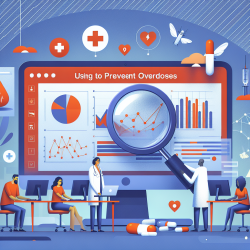Empowering Change: Harnessing Data for Overdose Prevention
In the ever-evolving landscape of public health, the need for innovative solutions to tackle pressing issues like drug overdoses is paramount. The research article "Development of a Real-Time Dashboard for Overdose Touchpoints: User-Centered Design Approach" offers a groundbreaking perspective on how data can be leveraged to enhance overdose prevention strategies. By implementing the outcomes of this research, practitioners can improve their skills and make a significant impact on their communities.
Understanding the Dashboard
The research highlights the development of a real-time dashboard designed to support Overdose Fatality Review (OFR) teams. This dashboard visualizes overdose touchpoint statistics, providing timely and actionable data on events that consistently precede fatal overdoses. By illuminating these touchpoints, the dashboard opens up additional opportunities for interventions at the population level, beyond what can be gleaned from individual fatality case reviews.
Key Features and Benefits
- Real-Time Data: The dashboard integrates real-time data, allowing OFR teams to access the most current information on overdose risk factors in their communities.
- Visualizations: It offers visual representations of key metrics, such as prevalence, interaction frequency, and time intervals between touchpoints and overdoses, making data interpretation more intuitive.
- County and State-Level Insights: Users can view data at both the county and state levels, providing a comprehensive overview of local and broader trends.
- Data-Driven Interventions: By identifying patterns and trends, the dashboard facilitates data-driven interventions and policy changes, ultimately aiming to reduce the number of preventable deaths.
Implementing the Dashboard
For practitioners looking to enhance their skills and make a tangible impact, integrating this dashboard into their practice is a valuable step. Here are some ways to implement the outcomes of this research:
- Training and Education: Ensure that OFR team members are trained in data interpretation and decision-making, maximizing the dashboard's potential.
- Collaborative Efforts: Engage with local health officials and stakeholders to collaboratively analyze data and develop targeted interventions.
- Continuous Feedback: Regularly assess the dashboard's effectiveness and gather feedback from users to refine and improve its functionality.
Encouraging Further Research
While the dashboard represents a significant advancement, there is always room for improvement and further research. Practitioners are encouraged to explore additional data sources, refine visualization techniques, and investigate new touchpoints that could enhance overdose prevention efforts.
To read the original research paper, please follow this link: Development of a Real-Time Dashboard for Overdose Touchpoints: User-Centered Design Approach.










